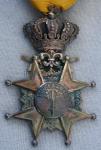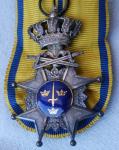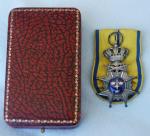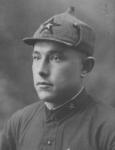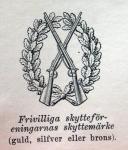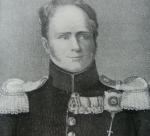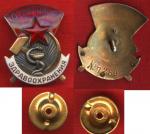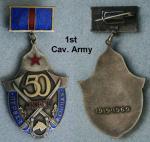-
Posts
408 -
Joined
-
Last visited
-
Days Won
1
Content Type
Profiles
Forums
Blogs
Gallery
Events
Store
Everything posted by kimj
-
Gentlemen, I'll try to get to the library this week. If I make it I'll post what I find later. If I don't make it I'll be there next week. /Kim
-
Here is what I found on Frans Emil Karlsson: Worker is most likely a farmhand as most people worked with farming at the time. The double names at line of awarder are first an official/government level organisation, in your case the Church. The second name, E. Weinberg, is the owner of the farm Frans worked at. Hope you have some use for it. /Kim
-
Easy is relative in this case. There is a data base with the awarded people for those years on line. But there is also a fee for useing it and I'm not paying for it. On the other hand the same data base is free when I use the computer at the library. So I have go there to get the info. If you can wait a few days I can get it as I'm going there anyway. Searching the data base is free and there is only one F.E. Karlsson who got the medal in 1921. So I guess that's your guy. /Kim
-
Nice pic! Here is more info from http://runeberg.org . ?Well known naval painter and Commander of the Royal navy Herman Gustaf af Sill?n died suddenly 29 December, 51 y.o.. A person who was an extremely hard working man, thorough in his work and had many different fields of interest. S. was without a doubt a victim of overstrain. [My comment: This last sentence is a euphemism for his suicide, not a thing society discussed openly.] Born 1857, commissioned 1876, Commander 2nd class 1891 and 1st class ten years later. 1900 promoted to head of military drill and NCO schools at the naval base Karlskrona. His last year was spent in Stockholm and he did much non-profit work. His naval paintings, done with great love, had gotten popular. As a recognition of his artistic work he was awarded ?Litteris et artibus?. Worth noticing is also that S. was the man who brought the question of a maritime museum to a, at least temporary, solution after many difficulties.? The same site lists some of his paintings. One of the paintings ?Stockholms str?m? (the body of water in central Stockholm) was made for the King of Romania. So he probably got that order for a painting well done. /Kim
-
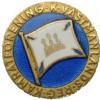
Denmark The Sign of the Sword / Sv?rdstecknet
kimj replied to kimj's topic in Northern European & Baltic States
Very nice 2nd class Peter!! /Kim -

Denmark The Sign of the Sword / Sv?rdstecknet
kimj replied to kimj's topic in Northern European & Baltic States
So the right English name would be Order of the Sword Merit Cross or even Order of the Sword Silver Merit Cross? Funny how things gets lost or added in an other language. Peter?s explanation is probably part of the answer. But the order system had been under attack from various groups before it was changed. How the debate about it went I don?t know. But the coalition parties of the right have been in power a couple of times since and haven?t re-established the award system yet. So it?s not only a question about one party?s politics. And yes Swedes still can get medals. But as a collector of awards.... Where is the enamel??? Mike: Perhaps my sources meant the idea of a silver award in an existing order. Thanks for the name correction. When all my sources are in Swedish I have problems with the right name. Mange tak! The orders you lucky foreigners can get are Order of the Polar Star and if you?re part of any Royal family or a head of state Order of the Seraphim. The Polar Star is a looker too. /Kim -

Sweden Swedish Order of the Sword. What period?
kimj replied to Veteran's topic in Northern European & Baltic States
Veteran: Balls on the tips of the cross arms became obligatory in 1856. So I guess some time before that year. Christophe: Sure there are rolls with awarded foreigners. But are you sure the ribbon is Swedish? A crown and swords is not typical for this order's ribbon. It could also be a Sign of the sword an award for NCOs and that roll would be harder to get as it's not published. /Kim -

Denmark The Sign of the Sword / Sv?rdstecknet
kimj replied to kimj's topic in Northern European & Baltic States
-

Denmark The Sign of the Sword / Sv?rdstecknet
kimj replied to kimj's topic in Northern European & Baltic States
-

Denmark The Sign of the Sword / Sv?rdstecknet
kimj posted a topic in Northern European & Baltic States
Here is a nice example of the Sign of the Sword or Sword Sign, not sure how to translate "Sv?rdstecknet" correctly. I found it at an auction last week and it came with a nice original box too. Perhaps I should tell the history of it for those not familiar with Swedish orders/medals. The officers of the Swedish army had the Order of the Sword to look forward too when they had put in enough years. But soldiers and NCOs had nothing award vise. To help the situation the Sign of the Sword and the Sword Medal (for privates and lower ranks) was established 23 February 1850. The main influence is believed to have been Denmark?s Dannebrogstecknet. To get the Sign of the Sword you had to put in 16 years of faithful service, of which at least six had to be as an NCO. When the soldier died the family had to return the award. It was not like the orders were the recipient?s relatives could pay to keep it. Returning the sign was praxis until 1897 when the rules changed and it could be ?bought? by the family to keep. The Sign of the Sword was awarded until 1974 when all Swedish orders became unavailable for Swedes. All different types of the Order of the Sword stopped being awarded then. This auction find is probably from 1900-1920ties. There is no study done, that I know of, so it?s just a guess. As it?s ?court mounted? I can?t show the reverse of this one, so a stand-in had to provide that pic. -
Interesting pics Ed! But the cap star Are these available for a reasonable price or are they sukhbator rare? Here are some more guys in the pointy hat. Notice the trio of political officers. /Kim
-
As usual when you get information from strange sources it isn?t that reliable. The ?soldatinstruktion? were outdated, not uncommon. The new (current) version of the badge was established in 1901, according to ?Svensk Uppslagsbok? (Swedish Encyclopaedia). It was also established in 1890, forget the other info that came from the society's web page. I don?t think there is a gold version of the army badge. The encyclopaedia has a rather good article on this subject and it only mentions the bronze and silver class. It?s printed in 1963. I can only concur with Peter on the year and value of your badge Hendrik. /Kim
-
The badges came in different classes, steel, bronze, silver and gold (1941). Depending of what points (counted from hits on the target) the shooter could qualify for the next level. Starting from steel, if he passed the requirements, and moving up from there. As you know Peter information on Swedish badges are not that great. But from a couple of ?soldatinstruktion? I found one of your badges. The books were issued in 1904 and 1909. So sometime between those years the badge changed. Notice the army version to the left, with an extra crown. /Kim
-
It?s the ?skyttem?rke? (badge for shooting) for the volunteer marksman society, it was established in 1893. If you look at the back you can see a bunch of stamps. If you can find a letter/number combination, like i.e. E8, I can tell you when it was made. They are still given out by the society today. /Kim
-

Denmark Danish General Anders Gjedde Nyholm
kimj replied to mravery's topic in Northern European & Baltic States
Here's a small bit to the puzzle: The Swedish awards. Knight of the Order of the Sword in 1906. Commander of 2nd Class Order of Vasa in 1912. Coincidentally the same year he was attending a manouver in Sweden /Kim -
Too bad. Years over early 1941 needs a visit to the archive in Stockholm to find out more about the awardee. A lot more work. Still, it's a nice medal. /Kim
-
This is a medal given out by the society ?Kongliga Patriotiska S?llskapet?/Royal Patriotic Society. It is (yes, still) awarded for long and faithful service (as the text say in Swedish: F?r L?ngvarig Trogen Tj?nst) in different fields. It comes in silver or gold in four classes: Large Small Jeton Emmery People who considered someone worthy of the medal nominated him or her to the society. If the society approved the nomination the people could then buy the medal for the nominated. Sometimes the cost for the medal was more than they wanted to pay and there was a problem to solve. If it?s awarded between 1900-1941 I can check who the guy was rather easily. You find the year it was made on the rim. Usually it says SILVER 1923 (or an other year). /Kim
-

Sweden Military Order Of The Sword
kimj replied to Yankee's topic in Northern European & Baltic States
I think this is a case of the Czar can do what he feels like and museum curators too. What I mean is that in the pic I have posted Alexander is wearing his bar with the top of all crosses covered. Maybe the crown on the order of the Sword made the ribbons look wrinkled. Solution: remove the crown. Later some ambitious museum curator wanted it to look nice. So he restored it with what he had available... Notice also on the pic that the czar is wearing the rare Swedish sign of the grand cross, the sword looking thingy below the other awards. Here are some nice links on the subject: http://arnell.cc/ http://www.ordersandmedals.net/ /Kim -

Soviet Veteran's badge of First Cavalry Army
kimj replied to kimj's topic in USSR: Soviet Orders, Medals & Decorations
There seems to some missunderstanding. The link Dave posted is just my badge question "over there". So there was no "censorship" needed. The badge seb16trs is refering to is in Paris, off-line. If you could get some scans or pics seb16trs we would be happy. I do not know what you meant with this. How many made? or What the statues were? From some Russian collector forum I saw a guess on 1000 made. But I doubt he had any hard evidence for that. I'll try to get some more info on the high quality fakes Marc, on SAF, was writing about. But that will take some time. Stay tuned to this thread for more to come.... /Kim -

Soviet Veteran's badge of First Cavalry Army
kimj replied to kimj's topic in USSR: Soviet Orders, Medals & Decorations
Thanks for the support Christian. I have looked at the numbers and I?m still finding details, some that match and some that differ slightly. One could go mad doing this. Serial numbers are missing on all badges/orders at some point in the manufacturing process. So who knows? That it?s missing isn?t hard evidence of anything, just that it?s odd. I disagree that I got a direct verdict on ?the other forum?. It was more like a nice way to say ?fake until proven real?. And it?s just an opinion. /Kim -

Soviet Excellent Medical Worker's Badge
kimj replied to Riley1965's topic in USSR: Soviet Orders, Medals & Decorations
Nice badge Doc! I have not heard anybody researching commissariat badges. But of course it?s possible... in theory. You just need somebody to dig in the archives of USSR Commissariat of Health and find the list. Here?s mine issued in 1942 to a nurse during the Leningrad blockade. So I guess your serial number makes it late 50-ties early 60ties? Just a guess. /Kim -

Soviet Veteran's badge of First Cavalry Army
kimj replied to kimj's topic in USSR: Soviet Orders, Medals & Decorations
Thanks Ed! Are the numbers gold plated? or is it a scanner effect? And here is a close up of mine. I must say that many things looks the same. But not 100%. Manufacture difference or.... Belaruski: It makes sense that a commemorative badge also could be some sort of award. I would guess that it had been awarded for something related to 1st Cav. Army. Perhaps a flattering historic book/article would be worth a badge... /Kim -

Soviet Veteran's badge of First Cavalry Army
kimj replied to kimj's topic in USSR: Soviet Orders, Medals & Decorations
It's a super nice badge Ed! I think it was seeing yours (or if it was Dave's back then) in living colour that made me want one in the first place. Did it come with any document? A closer look on the years on the reverser would be helpful. I'll try to get a better pic of mine. But it's tricky with a digital cam. Perhaps Kravchenko was the toughest one-year old around.... /Kim -

Soviet Veteran's badge of First Cavalry Army
kimj replied to kimj's topic in USSR: Soviet Orders, Medals & Decorations
There are no signs of any serial numer on it. But that only raises more questions. Why, if this is faked, would you fake something perfect and forget a basic thing like that. Ok, maybe some of the guys who make their living from producing fakes aren't that clever. But they got the rest of the reverse right. Does anybody have an example that we can compare mine with? /Kim -
A new addition to the collection: Veteran of the First Cavalry Army. 1st cav. Army was THE most famous civil war unit with guys like Budenny, Voroshilov, Timoshenko, Meretskov, Zhukov etc. in its ranks. This is the veteran?s badge for me and I have been looking for a while to find one. Have anyone seen fakes of this one...?? Or am I just being paranoid.... Here is one in Ed?s thread: http://gmic.co.uk/index.php?showtopic=6207&st=71 /Kim




